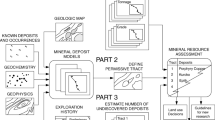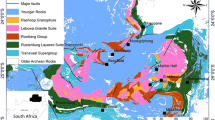Abstract
The Pb–Zn sulfide concentrations hosted by dolomitized Cambrian carbonates in Southeast Missouri are world-class Mississippi Valley Type (MVT) deposits. These deposits commonly are in sites where local Precambrian basement highs resulted in depositional pinchouts of the basal Cambrian sandstones that served as a regional aquifer for basinal fluid migration driven by late Paleozoic Ouachita deformation. Mineralization also appears to be spatially related to regional faults that probably served as local fluid conduits. Understanding spatial associations between sites of known mineralization and regional geology, geochemistry, and geophysics in Southeast Missouri will be a useful guide in future exploration efforts in this region and for similar geologic settings globally. The weights-of-evidence method is used to evaluate regional geology, geochemistry, and geophysical datasets and produce favorability maps for MVT deposits in Southeast Missouri. Host rock characteristics, regional structural controls, stream sediment geochemistry, and proximity to basement highs appear to be the most useful data for predicting the location of the major deposits. This work illustrates the potential utility of mineral potential modeling to prioritize areas for exploration and identify permissive areas for undiscovered MVT mineralization.


















Similar content being viewed by others
References
Agterberg, F. P., & Cheng, Q. (2002). Conditional independence test for weights-of-evidence modeling. Natural Resources Research,11, 249–255.
Allingham, J.W. (1976). Interpretation of aeromagnetic anomalies in Southeastern Missouri, US Geological Survey, Open File Report No. 76-868.
Bickford, M. E., & Mose, D. G. (1975). Geochronology of Precambrian rocks in the St. Francois Mountains, Southeastern Missouri. Geological Society of America Special Paper, No. 165.
Blakey, R. C. (2003). Carboniferous–Permian palaeogeography of the assembly of Pangea. In T. E. Wong (Ed.), Proceedings of the XVth international congress on Carboniferous and Permian stratigraphy (pp. 443–456). Amsterdam: Royal Dutch Academy of Arts and Sciences.
Bonham-Carter, G. F. (1994). Geographic information systems for geoscientists: Modeling with GIS. Oxford: Pergamon Press.
Carranza, E. J. M. (2009). Geochemical anomaly and mineral prospectivity mapping in GIS. Amsterdam: Elsevier.
Cheng, Q., & Agterberg, F. P. (1999). Fuzzy weights-of-evidence method and its application in mineral potential mapping. Natural Resources Research,8, 27–35.
Chung, C. J. F., & Fabbri, A. G. (2003). Validation of spatial prediction models for landslide hazard mapping. Natural Hazards, 30, 451–472.
Cordell, L., & Knepper, D. H. (1987). Aeromagnetic images: Fresh insight to the buried basement, Rolla quadrangle, southeast Missouri. Geophysics,52, 218–231.
D’Ercole, C., Groves, D. I., & Knox-Robinson, C. M. (2000). Using fuzzy logic in a geographic information system environment to enhance conceptually based prospectivity analysis of Mississippi Valley-type mineralization. Australian Journal of Earth Sciences,47, 913–927.
Daneshfar, B., Desrochers, A., & Budkewitsch, P. (2006). Mineral-potential mapping for MVT deposits with limited data sets using Landsat data and geological evidence in the Borden Basin, Northern Baffin Island, Nunavut, Canada. Natural Resources Research,15, 129–149.
Daniels, V. B. A. C. D., Patricia, C. A. F. I. H., Mark, H. R. K. W. M., Victoria, P. C. R. W. R., Ronald, R. S. S. S. S., Phillips, S. J. V., & Ravat, J. D. (2002). Digital data grids for the magnetic anomaly map of North America, Retrieved March 31, 2016 from the Regional Geospatial Service Center of the University of Texas El Paso, http://gis.utep.edu/subpages/GMData.html.
Derby, J. R., Fritz, R. D., Longacre, S. A., Morgan, W. A., & Sternbach, C. A. (Eds.). (2012). Memoir 98: The Great American Carbonate Bank: The geology and economic resources of the Cambrian-Ordovician Sauk megasequence of Laurentia. Tulsa: AAPG. https://www.aapg.org/publications/special-publications/books/review/articleid/45713/memoir-98-the-great-american-carbonate-bank-the-geology-and-economic-resources-of-the-cambrian-ordovician-sauk-megasequence-of-laurentia.
ESRI. (2014). ArcGIS desktop, release 10.3. Redlands, CA: Environmental Systems Research Institute.
Fabbri, A. G., & Chung, C. J. (2008). On blind tests and spatial prediction models. Natural Resources Research,17, 107–118.
Fullagar, P. K., Pears, G., Hutton, D., & Thompson, A. (2004). 3D gravity and aeromagnetic inversion for MVT lead-zinc exploration at Pillara, Western Australia. Exploration Geophysics,35, 142–146.
Gutierrez, G. N. (1987). Controls on ore deposition in the Lamotte Sandstone. Goose Creek Mine, Indian Creek Subdistrict, southeast Missouri. M.S. Thesis, The University of Texas at Austin.
Hagni, R. D. (1986). Mineral paragenetic sequence of the lead-zinc-copper-cobalt-nickel ores of the Southeast Missouri lead district. In J. R. Craig, et al. (Eds.), Mineral paragenesis (pp. 90–132). Athens, Greece: Theophrastus Publications S.A.
Horrall, K. B., Farr, M. R., & Hagni, R. D. (1996). Evidence for focusing of Mississippi Valley-type ore fluids along the Bloomfield Lineament Zone, Southeast Missouri. In Sangster, D.F. (Ed.), Carbonate-hosted lead–zinc deposits (pp. 400–412). Special Publication No. 4, Society of Economic Geologists.
Kisvarsanyi, E. B. (1979). Structure contour map of buried Precambrian basement-rock surface, Rolla 1 degree by 2 degrees quadrangle and adjacent areas, Missouri (No. 1001-B).
Kisvarsanyi, G. (1977). The role of the Precambrian igneous basement in the formation of the stratabound lead–zinc–copper deposits in Southeast Missouri. Economic Geology,72, 435–442.
Kolata, D. R. (2005). Bedrock geology of Illinois [vector digital data], 1:500,000, Illinois Map 14.
Leach, D. L., & Rowan, E. L. (1986). Genetic link between Ouachita foldbelt tectonism and the Mississippi Valley-type lead–zinc deposits of the Ozarks. Geology,14, 931–935.
Leach, D. L., Taylor, R. D., Fey, D. L., Diehl, S. F., & Saltus, R. W. (2010). A deposit model for Mississippi Valley type lead–zinc ores. US Geological Survey, Scientific Investigations Report 2010–5070.
Leach, D. L., Viets, J. B., Foley-Ayuso, N., & Klein, D. P. (1995). Mississippi Valley-type Pb–Zn deposits. In Preliminary compilation of descriptive geoenvironmental mineral deposit models (pp. 95–831). US Geological Survey, Open-File Report.
Missouri Department of Natural Resources, Lead information, (n.d.), retrieved May 11, 2016 from http://dnr.mo.gov/env/lead.htm.
Missouri Department of Natural Resources, Missouri lead mining history by county, (n.d.), retrieved November 10, 2016 from https://dnr.mo.gov/env/hwp/sfund/lead-mo-history-more.htm.
MO 2011 Bedrock 500K [vector digital data], 1:500,000 (2011). Missouri Department of Natural Resources (DNR), Division of Geology and Land Survey (DGLS), Geological Survey Program (GSP). Retrieved December 2, 2015 from ftp://msdis.missouri.edu/pub/Geological_Geophysical/MO_2011_Bedrock_500K_shp.zip.
National Elevation Dataset. (2009). [raster digital data], Sioux Falls, SD, U.S. Geological Survey. http://nationalmap.gov.
Ohle, E. L. (1990). A comparison of the Old Lead Belt and the New Lead Belt in Southeast Missouri. Economic Geology,85, 1894–1895.
Ohle, E. L., & Brown, J. S. (1954). Geologic problems in the Southeast Missouri lead district. Geological Society of America Bulletin,65, 201–222.
Pratt, W. P., Erickson, R. L., Jenson, S. K., & Hastings, D. A. (1986). The Rolla and Springfield, Missouri, CUSMAP resource assessments. In S. M. Cargill & S.B. Green (Eds.), Prospects for mineral resource assessments on public lands. US Geological Survey, Circular 980.
Pratt, W. P., Erickson, R. L., Mosier, E. L., Odland, S. K., Erickson, M. S., Viets, J. G., Miller, M. H., Heyl, A. V., Anderson, K. H., Martin, J. A., Satterfield, I. R., Wharton, H. M., & Middendorf, M. A. (1981). Mississippi Valley-type base-metal deposits in the Bonneterre formation and Lamotte sandstone. In W. P. Pratt (Ed.), Metallic mineral-resource potential of the Rolla 1 × 2 quadrangle, Missouri, as appraised in September 1980, US Geological Survey, Open File Report 81-518.
Raines, G. L. (2006). Resource materials for a GIS spatial analysis course: Revision of lectures. US Geological Survey, Open File Report 01-221, version 1.1.
Schmitt, E. (2010). Weights-of-evidence mineral prospectivity modelling with ArcGIS. EOSC 448 directed studies. Vancouver: University of British Columbia.
Seeger, C. M. (2008). History of mining in the Southeast Missouri lead district and description of mine processes, regulatory controls, environmental effects, and mine facilities in the Viburnum Trend Subdistrict. US Geological Survey, Scientific Investigations Report 2008-5140.
Sibson, R. (1981). A brief description of natural neighbour interpolation. Interpreting Multivariate Data,21, 21–36.
Smith, S. M. (2006). Reformatted data from the National Uranium Resource Evaluation (NURE) hydrogeochemical and stream sediment reconnaissance (HSSR) program, version 1.40, US Geological Survey, Open-File Report 97-492.
Snyder, F. G., & Gerdemann, P. E. (1968). Geology of the Southeast Missouri lead district. In J. D. Ridge (Ed.), Ore deposits of the United States, 1933–1967, Graton-Sales volume (pp. 327–358). New York: American Institute of Mining, Metallurgical, and Petroleum Engineers.
Symons, D. T., Lewchuk, M. T., & Leach, D. L. (1998). Age and duration of the Mississippi Valley-type mineralizing fluid flow event in the Viburnum Trend, Southeast Missouri, USA, determined from palaeomagnetism. In J. Parnell (Ed.), Dating and duration of fluid flow and fluid–rock interaction (pp. 27–39). London: Geological Society, Special Publication No. 144.
Tarr, W. A. (1936). Origin of the southeastern Missouri lead deposits, part 1. Economic Geology,31, 712–754.
Thacker, J. L., & Anderson, K. H. (1977). The geologic setting of the Southeast Missouri lead district; regional geologic history, structure and stratigraphy. Economic Geology,72, 339–348.
U.S. Geological Survey. (2004). National Uranium Resource Evaluation (NURE) hydrogeochemical and stream sediment reconnaissance data. U.S. Geological Survey, Denver, Co. https://mrdata.usgs.gov/nure/sediment/.
Wharton, H. M. (1975). Introduction to the Southeast Missouri lead district. Missouri Geological Survey, Report of Investigations no. 58.
Williams, N. D. (2017). A predictive exploration model for MVT Pb–Zn mineralization in central Texas: Insights from the Southeast Missouri lead district. M.S. Thesis, The University of Texas at Austin.
Wisniowiecki, M. J., Van der Voo, R., McCabe, C., & Kelly, W. C. (1983). A Pennsylvanian paleomagnetic pole from the mineralized Late Cambrian Bonneterre formation, Southeast Missouri. Journal of Geophysical Research: Solid Earth,88, 6540–6548.
Wu, Y., & Beales, F. (1981). A reconnaissance study by paleomagnetic methods of the age of mineralization along the Viburnum Trend, Southeast Missouri. Economic Geology,76, 1879–1894.
Acknowledgments
This study was supported by funding from student research grants from the Society of Economic Geologists McKinstry Fund and the American Association of Petroleum Geologists Donald F. Towse Memorial Grant. Additional support was provided by the III C. E. Yager Professorship of the Jackson School of Geosciences and by the State of Texas Advanced Resource Recovery Program through the Bureau of Economic Geology, Mineral Resources Program.
Author information
Authors and Affiliations
Corresponding author
Rights and permissions
About this article
Cite this article
Williams, N.D., Elliott, B.A. & Kyle, J.R. A Predictive Geospatial Exploration Model for Mississippi Valley Type Pb–Zn Mineralization in the Southeast Missouri Lead District. Nat Resour Res 29, 285–310 (2020). https://doi.org/10.1007/s11053-020-09618-2
Received:
Accepted:
Published:
Issue Date:
DOI: https://doi.org/10.1007/s11053-020-09618-2




